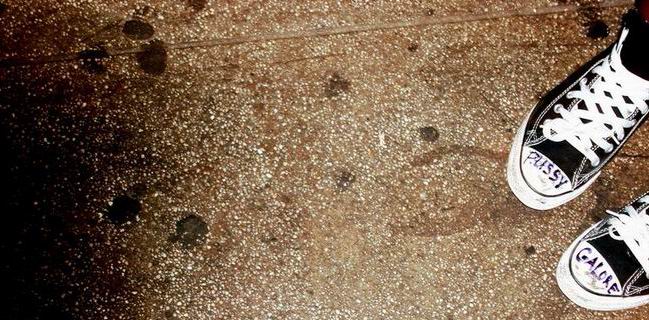
Always been confused about the whole circumcision thing. All I know is that uncircumcised penises look weird sort of like a swiss roll (Like lil would say) or a slinky with skin over it...mad lumpy (eh). But there are many stories behind why circumcision is important ranging from religion to sexual effects. I did some research and this is what I've discovered.
Male circumcision is the removal of some or all of the foreskin (prepuce) from the penis. The word "circumcision" comes from Latin circum (meaning "around") and cædere (meaning "to cut"). Early depictions of circumcision are found in cave paintings and Ancient Egyptian tombs, though some pictures are open to interpretation. Religious male circumcision is considered a commandment from God in Judaism.In Islam, though not discussed in the Qur'an, male circumcision is widely practised and most often considered to be a sunnah.It is also customary in some Christian churches in Africa, including some Oriental Orthodox Churches. According to the World Health Organization (WHO), global estimates suggest that 30% of males are circumcised, of whom 68% are Muslim. The prevalence of circumcision varies mostly with religious affiliation, and sometimes culture. Most circumcisions are performed during adolescence for cultural or religious reasons; in some countries they are more commonly performed during infancy.

Circumcised

Uncircumcised
Jewish law states that circumcision is a 'mitzva aseh ("positive commandment" to perform an act) and is obligatory for Jewish-born males and for non-circumcised Jewish male converts. It is only postponed or abrogated in the case of threat to the life or health of the child It is usually performed by a mohel on the eighth day after birth in a ceremony called a Brit milah (or Bris milah, colloquially simply bris), which means "Covenant of circumcision" in Hebrew. It is considered of such importance that in some Orthodox communities the body of an uncircumcised Jewish male will sometimes be circumcised before burial. Although 19th century Reform leaders described it as "barbaric", the practice of circumcision "remained a central rite" and the Union for Reform Judaism has, since 1984, trained and certified over 300 practicing mohels under its "Berit Mila Program".Humanistic Judaism argues that "circumcision is not required for Jewish identity."
In Islam, circumcision is mentioned in some hadith (it is referred as Khitan), but not in the Qur'an. Some Fiqh scholars state that circumcision is recommended (Sunnah); others that it is obligatory. some have quoted the hadith to argue that the requirement of circumcision is based on the covenant with Abraham.While endorsing circumcision for males, Islamic scholars note that it is not a requirement for converting to Islam.
Some medical associations take the position that the parents should determine what is in the best interest of the infant or child, but the Royal Australasian College of Physicians (RACP) and the British Medical Association (BMA) observe that controversy exists on this issue.The BMA state that in general, "the parents should determine how best to promote their children’s interests, and it is for society to decide what limits should be imposed on parental choices." They state that because the parents' interests and the child's interests sometimes differ, there are "limits on parents' rights to choose and parents are not entitled to demand medical procedures contrary to their child's best interests." They state that competent children may decide for themselves.UNAIDS states that "[m]ale circumcision is a voluntary surgical procedure and health care providers must ensure that men and young boys are given all the necessary information to enable them to make free and informed choices either for or against getting circumcised.

The American Academy of Pediatrics (1999) stated: "Circumcision has been suggested as an effective method of maintaining penile hygiene since the time of the Egyptian dynasties, but there is little evidence to affirm the association between circumcision status and optimal penile hygiene."
An inflammation of the glans penis and foreskin is called balanoposthitis; that affecting the glans alone is called balanitis. Both conditions are usually treated with topical antibiotics (metronidazole cream) and antifungals (clotrimazole cream) or low-potency steroid creams. Although not as necessary as in the past, circumcision may be considered for recurrent or resistant cases. Escala and Rickwood recommend against a policy of routine infant circumcision to avoid balanitis saying that the condition affects no more than 4% of boys, does not cause pathological phimosis, and in most cases is not serious.
The American Cancer Society (2009) stated, "Most experts agree that circumcision should not be recommended solely as a way to prevent penile cancer."
The American Academy of Pediatrics (1999) stated that studies suggest that neonatal circumcision confers some protection from penile cancer, but circumcision at a later age does not seem to confer the same level of protection. Further, because penile cancer is a rare disease, the risk of penile cancer developing in an uncircumcised man, although increased compared with a circumcised man, remains low.[65]
The age-adjusted annual incidence of penile cancer is 0.82 per 100,000 in Denmark, 2.9-6.8 per 100,000 in Brazil, 0.9 to 1 per 100,000 in the USA, and 2.0-10.5 per 100,000 in India. Researchers have reported that the risk of penile cancer is greater in never-circumcised men than in men who had been circumcised at birth; estimates of the relative risk include 3 and 22 -Via wikipedia

No comments:
Post a Comment